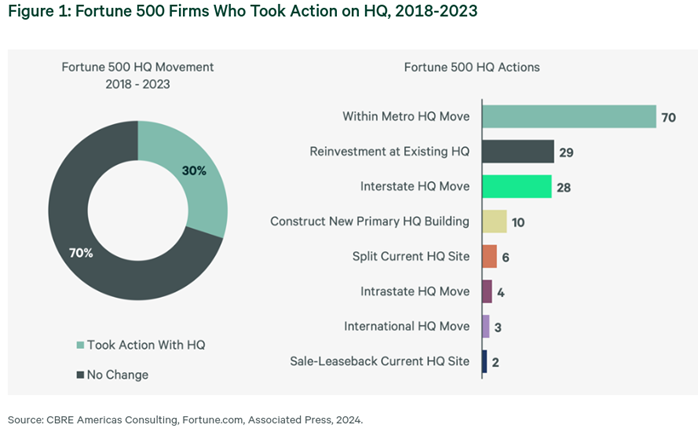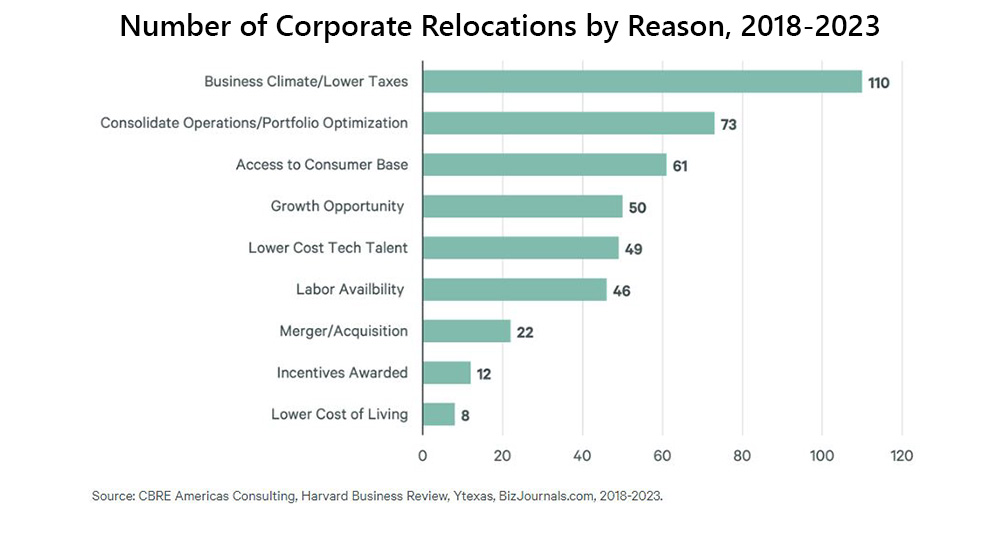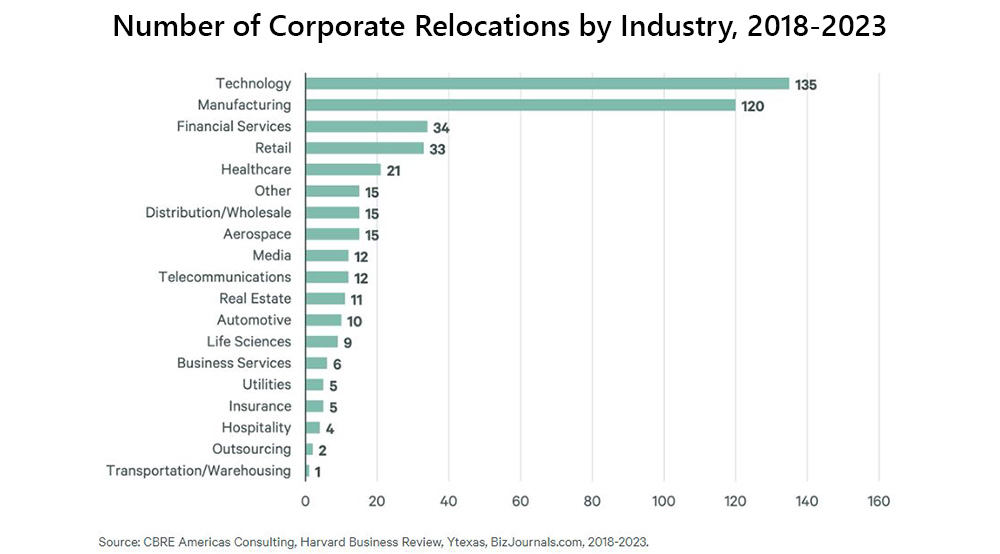- Navigator
- Business Retention and Expansion (BRE)
- Prospecting and Business Attraction

Corporate relocation is a big deal and can impact the economy of entire regions, negatively for the area the company is moving away from and positively for the area the company is moving to.
In the last few years, a corporate relocation trend has emerged involving US companies of all sizes, including large Fortune 500 companies and heavy hitters like Tesla, SpaceX, and Chevron, which all recently announced they would relocate their operations from California to Texas.
According to a study conducted by HireAHelper, there have been over 590 corporate headquarters relocations within the US since the beginning of 2022, with nearly one in 12 companies (8%) making some type of relocation during 2022-2023. This is a 29% increase over the previous year.
Another study by CBRE found that over 30% of Fortune 500 companies have had a major relocation or physical move over the past six years. Many of these moves were within the same metro area, another aspect of corporate relocation that is often overlooked. Relocations within the same community obviously don’t show in the interstate capital investment or job creation data, but they still do impact local real estate markets.
Interestingly, that same study by CBRE identified 70 Fortune 500 companies that relocated their headquarters within the same metro area from 2018-2023, compared to 28 interstate headquarters relocations. It’s also worth noting that the study also showed 29 companies chose to reinvest in or expand their existing headquarters locations. 
This increase in corporate relocations underscores a significant shift in business strategy, with companies seeking new environments that align more closely with their operational goals and workforce needs. It also indicates that economic development organizations (EDOs) need to take steps to understand why these relocations are occurring and evaluate their ability to effectively attract and retain businesses within their communities.
The data dashboard below provides examples of companies that have relocated in recent years, including details about the states they moved to, where they came from, and the incentives they received in the move (original research completed by Camoin Associates):
What Drives Corporate Relocation?
So, why does corporate relocation happen, and how can EDOs capitalize on this trend?
The following examples illustrate the importance of financial incentives, business-positive tax environments, and strategic geographic locations in corporate relocation decisions. States like Texas, Florida, and others have attracted major corporations by offering competitive packages that align with business needs. By recognizing and acting on these major trends and patterns, EDOs can tailor their strategies to better attract and retain businesses in their communities:
Business Climate and Tax Savings
The most powerful motivation for a company to relocate is usually economic incentives or cost savings. State and local governments often offer very attractive packages to woo new companies, including corporate tax breaks, grant funding, and subsidies. These incentives can reduce a business’s operational costs, making relocation an appealing option.
For instance, Texas is known to have a business-friendly tax environment with no corporate income tax and a competitive tax structure. That worked to its advantage when companies such as Tesla and SpaceX intended to expand their operations while minimizing their tax liabilities. When compared to California’s higher taxes and stricter regulatory environment, Texas looks quite attractive to many companies.
Economic incentives are more than just tax breaks. Grants for workforce development, infrastructure improvements, and expedited permitting processes are all commonly used to entice companies. EDOs must skillfully package these incentives to support the strategic goals of their target companies.
Companies are increasingly relocating to states with favorable tax environments, low or no corporate income taxes, and lower overall operational costs.
EDOs in states with less favorable tax environments should advocate for competitive tax incentives and work with local governments to create business-friendly policies. Highlighting any existing financial benefits and collaborating with state leaders to introduce new incentives can be effective in attracting companies.
Cost of Office Space
Technology and finance companies are leading the charge when it comes to corporate relocation, and one of the primary reasons driving this is the cost of office space.
Research from HireAHelper using SEC Filings data shows that 62% of companies that chose to relocate since 2022 moved their operations to cities with smaller populations and lower office space costs.
This is a trend EDOs must consider when they are looking to attract companies with big office space needs.
Consolidation of Operations
Companies are increasingly merging business units, closing unnecessary facilities, or relocating to cut costs and boost efficiency. This trend often results from mergers, market changes, or strategic shifts. Companies looking to consolidate seek locations with good incentives, infrastructure, and access to skilled labor.
EDOs can make their regions attractive to companies looking to optimize operations by understanding consolidation drivers and offering targeted support. This approach can help EDOs turn the consolidation trend into an opportunity for regional growth and development.
Infrastructure
Infrastructure plays a pivotal role in a company’s decision to relocate. Businesses require reliable transportation networks, energy supplies, and communication systems to operate efficiently. The quality and accessibility of these types of infrastructure can make or break a relocation decision.
For instance, Texas’s robust infrastructure has been a significant draw for companies in various industries. The state’s extensive highway system, major airports, and deepwater ports provide companies with the logistical capabilities needed to move goods and people efficiently. Additionally, Texas’s energy infrastructure, including its abundant natural gas supply, is particularly appealing to manufacturing and tech companies that require reliable and affordable power. However, a rash of weather-related power outages across the state during the last few years has revealed a weak point in that infrastructure that may reduce Texas’s appeal if not addressed.
Infrastructure was the highest-ranked metric used to analyze states’ business competitiveness in CNBC’s latest Statewide Business Rankings for 2024, and it continues to be an important factor for businesses considering their next move.
Beyond physical infrastructure, digital connectivity is also becoming increasingly important, especially for tech-driven companies. The availability of high-speed internet, data centers, and cutting-edge telecommunications infrastructure can be decisive factors for businesses considering relocation. Texas’s investment in digital infrastructure has made it a prime location for tech companies, allowing them to operate on the cutting edge of innovation.
EDOs should prioritize understanding and improving local infrastructure to make their regions more attractive to potential relocators. This might involve advocating for state and federal investments, partnering with private companies to enhance digital infrastructure, or ensuring that transportation networks are equipped to handle the needs of growing businesses.
Location and Accessibility
Companies are selecting relocation sites based on strategic advantages such as proximity to key markets, transportation hubs, and supply chains. States like Tennessee and Texas, with their central locations and robust transportation infrastructure, have successfully attracted companies like Nissan and Caterpillar.
Texas’s central location in the United States makes it an ideal hub for companies looking to serve both domestic and international markets. Its proximity to Mexico is particularly advantageous for manufacturing companies that rely on cross-border supply chains. Additionally, Texas’s location within the Sun Belt has made it a prime spot for companies looking to capitalize on population growth and economic expansion in the southern US.
Companies may also prefer to move into regions with a solid supply base where they would be near customers or other complimentary businesses. These types of assets create an environment that may result in further innovation and efficiency, making a location even more attractive.
EDOs can leverage their region’s strategic location by highlighting advantages such as access to major markets, transportation networks, and natural resources. By demonstrating how a location can help businesses optimize their operations and reach their target markets more efficiently, EDOs can make a compelling case for relocation.
Workforce Availability and Quality
Access to a skilled workforce is still a top priority for companies, particularly in industries like technology, manufacturing, and financial services. Relocations to regions with strong education systems, workforce development programs, and a growing talent pool, such as Austin and Nashville, reflect this trend.
If a company wants to expand or relocate, it will often require access to workers with specific skills. Some of the things businesses look at when evaluating a potential location include the quality of local school districts and proximity to top universities and community colleges that are supported by ongoing workforce training programs.
States like Texas, for instance, are luring tech companies such as Oracle and Hewlett Packard Enterprises with their growing technology talent pool. Because the state has significantly invested in education and workforce training, there are plenty of skilled workers available across sectors, including technology, manufacturing, and energy. To make it even more attractive, companies can afford to attract and retain top talent because the cost of living in Texas is significantly lower than that of states like California, Washington, and New York. This applies not just to the workforce as a whole but also to the wider business ecosystem.
EDOs should focus on workforce development initiatives that align with the needs of their target industries. Partnering with local educational institutions and offering training programs can help create a pipeline of talent that attracts businesses. Additionally, EDOs should continue to actively promote the quality and availability of their local workforce.
Regulatory Environment
Companies are increasingly seeking locations where the regulatory environment is conducive to business growth, with fewer barriers to entry and more streamlined processes.
In recent years, California has become known for its stringent regulations, particularly in its environmental, labor, and land use laws. While these regulations help protect the state’s natural and human resources, they can also increase operational costs and complexity for businesses.
In contrast, Texas has positioned itself as a state with fewer regulations, offering companies more flexibility in how they operate. This regulatory freedom has been a key factor in attracting companies like Tesla, which has ambitious plans for rapid expansion and innovation.
EDOs must understand the regulatory pressures that companies face and work with local governments to create a business environment that balances regulation with economic growth. This might include advocating for regulatory reforms, offering assistance in navigating compliance issues, or providing clear and consistent communication about regulatory expectations.
Tech, Manufacturing, and Finance Lead the Corporate Relocation Charge
Technology, manufacturing, and financial services companies are at the forefront of the corporate relocation trend, with a strong focus on accessing skilled workers, benefiting from business-friendly environments, and obtaining less expensive office space.
When it comes to Fortune 500 companies, Texas has gained 10 net headquarters from 2018-2023, with Florida coming in second with four net headquarters during the same time frame.
The Biggest Winners and Losers
Texas and Florida continue to be major destinations for corporate relocation, driven by their favorable tax climates, lower operational costs, and strategic locations. HireAHelper’s analysis of SEC Filing data shows that Florida saw a net positive increase in new corporate headquarters of over 86% in 2022-2023, with Texas seeing a 71% increase during that same time.
On the other hand, Washington state experienced the highest net loss of corporate headquarters, with an 83% decline since the beginning of 2022. New York and California saw the next biggest net loss of corporate headquarters, with declines of 51% and 46%, respectively.
These losses may be driven by factors such as high operational costs, regulatory challenges, and shifting market dynamics.
Certain cities have become magnets for corporate relocation. Waltham, MA, Burlington, MA, and Spring, TX, saw the most significant influx of new corporate headquarters, with increases of 175%, 133%, and 100%, respectively. These cities likely offer the right mix of business-friendly policies, access to talent, and quality of life to attract new corporate residents.
Cities in Florida, Texas, Tennessee, and North Carolina all saw double-digit increases in their net corporate headquarters.
Conversely, Cambridge, MA, Seattle, WA, and San Jose, CA, witnessed the largest net losses of corporate headquarters over the past year, with declines of 40%, 37%, and 25%, respectively.
These losses could be attributed to rising costs of living, traffic congestion, and competitive disadvantages compared to other emerging business hubs.
Key Takeaways for EDOs
Leverage Regional Assets
EDOs must focus on leveraging their region’s unique assets to create a compelling value proposition for potential relocators. This might involve highlighting the availability of a skilled workforce, a strategic location, or robust infrastructure. EDOs should work with local stakeholders, including educational institutions, industry associations, and government agencies, to ensure that their region’s strengths are fully aligned with the needs of their target industries.
For instance, Tennessee has been highly successful in attracting automotive manufacturing companies by leveraging its central location, strong logistics infrastructure, and skilled workforce. The Tennessee Department of Economic and Community Development (TNECD) has focused on building a robust ecosystem for the automotive industry, offering targeted incentives and workforce training programs tailored to the needs of manufacturers.
As a result, companies like Nissan, General Motors, and Volkswagen have established major operations in the state, creating thousands of jobs and solidifying Tennessee’s reputation as a leader in automotive manufacturing.
Proactive and Customized Engagement is Key
Successful relocations often involve early and proactive engagement from EDOs, including offers of customized incentive packages and support tailored to each company’s specific needs.
The Greater Austin Chamber of Commerce in Texas exemplifies this approach. By focusing on the region’s strengths in technology, education, and quality of life, the Chamber has been instrumental in attracting tech giants like Apple, Oracle, and Tesla. The Chamber worked closely with these companies to understand their needs and offered customized incentives and support, including assistance with site selection, workforce development, and navigating local regulations. The result has been a tech boom in Austin, with the city emerging as one of the most vibrant tech hubs in the US.
In the current environment, EDOs must move beyond traditional approaches and adopt more proactive and customized strategies to attract and retain companies. This involves not only offering competitive financial incentives but also understanding the unique needs of each company and crafting packages that align with their strategic goals.
EDOs should focus on building strong relationships with businesses early in the decision-making process, providing tailored solutions that address specific concerns such as workforce availability, regulatory hurdles, and infrastructure requirements.
By understanding the key drivers behind corporate relocation decisions, EDOs can craft targeted strategies to attract and retain businesses. Successful examples from states like Texas, Florida, Tennessee, North Carolina, and others illustrate the importance of leveraging regional strengths, promoting quality of life, fostering innovation, and engaging proactively with businesses.
Camoin Associates offers a variety of business attraction and retention services to communities of all sizes. Contact us today to learn more.
Learn more about our Target Industry Analytics and Strategy Services
Learn more about our Workforce Development and Talent Attraction Services
Learn more about our Prospecting and Business Attraction Services
Learn more about our Business Retention and Expansion Services
📍 Related Articles:




